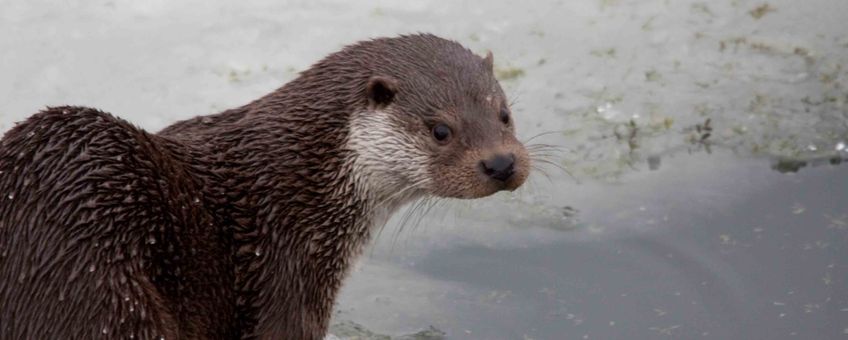
Soon after releasing the first few otters, some of those left their areas of release and moved elsewhere. Now, 17 years later, the otter has spread over a large part of specifically the North-east Netherlands (figure 1). Genetic research revealed that around 360 otters were living in this country on 1 October 2018 (figure 2). Overijssel, Friesland, Flevoland and Drenthe have the largest numbers of the otter population (figure 3). A smaller number settles in Gelderland, South-Holland, Groningen and North-Holland. Only in Utrecht, Zeeland, North-Brabant and Limburg no locations have been spotted at all (yet).
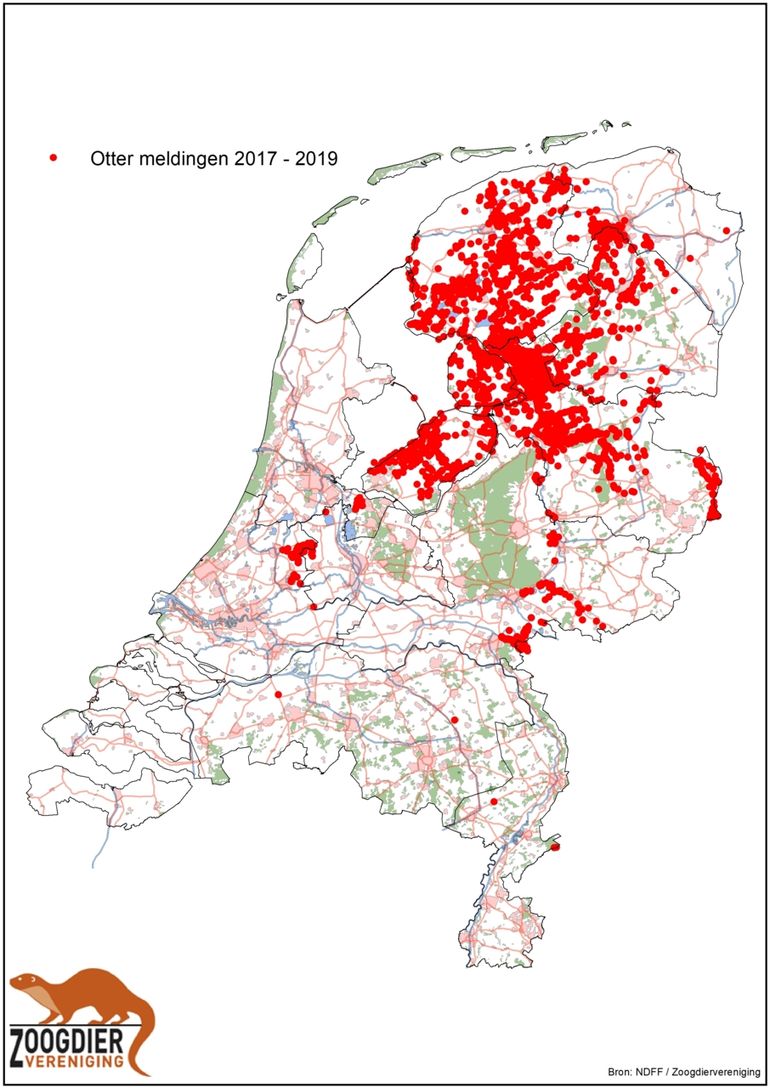
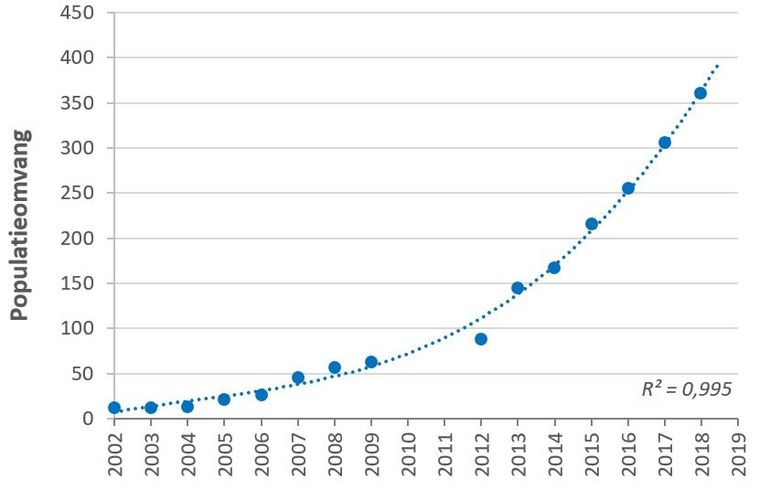
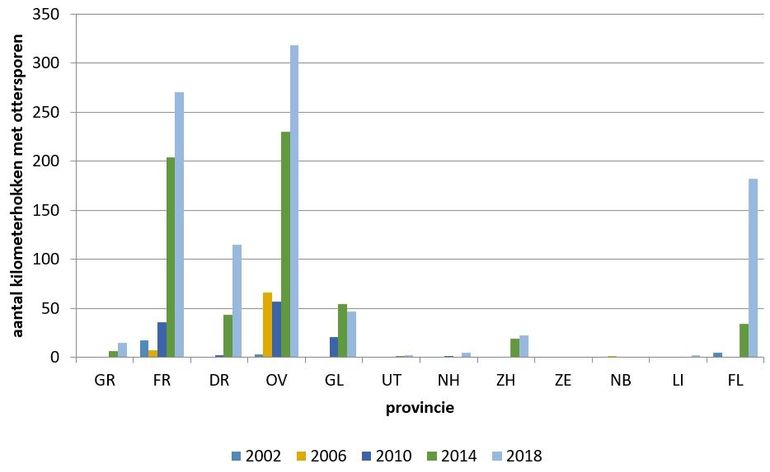
High number of road traffic victims
Otters may roam over large distances, whereby some get killed by traffic. Reports on otters from the south of the Netherlands up to now, mainly involve roaming or killed animals. In 2018, for the country as a whole, almost one hundred dead otters were reported as a road traffic victim. A clear relationship exists between the number of road-kills and the estimated size of the otter population. The larger the population, the more otters will be killed by traffic (figure 4). Despite the high number of road fatalities, otters have been capable of spreading their range. Even minimally one otter has managed to settle near Antwerp in Belgium. In Germany also the occasional otter from the Netherlands is reported.
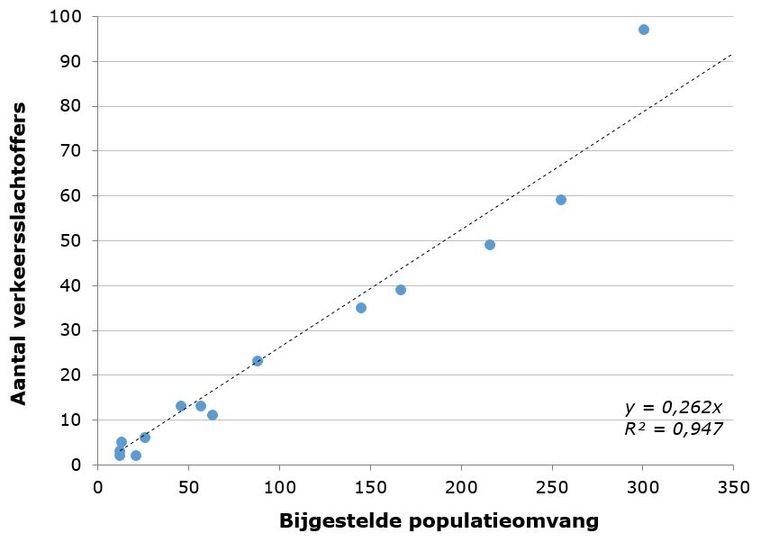
Genetic exchange necessary
Exchange with Germany is important for a sustainable settlement of otters in the Netherlands. The Dutch population has a narrow genetic basis, which makes it sensitive to the negative effects of inbreeding. Such an impact can be prevented by exchange among otters from the Netherlands and Germany, that has a much larger population. Although over the past few years some otters from Germany have crossed the border spontaneously, these numbers still remain quite small. This is caused by an extended barrier in the landscape of the west of Germany, that makes this into an unfit habitat. Adjustments to landscapes also in Germany, would make it easier for them to reach the Netherlands. This is desirable for the development of a sustainable otter population in the long run. Besides this, attention is still needed to reduce the number of road-kills by mitigating infrastructure measures in the Netherlands. Especially on those places, where multiple fatalities with otters already have occurred. Another point of attention is the need for prevention of otters drowning in (illegal) fish fykes. Mortality of otters can be lowered with the use of the so called stop-grids, letting fish in the nets but blocking an otter.
Collaboration
Since 2002, 31 otters have been released in a number of restock areas in the northwest (the 'Kop') of Overijssel and Southeast Friesland. After that, from 2008 onwards relocation of 22 otters has been carried out in the east and north-east of the Netherlands. The initial reintroduction was carried out by Wageningen Environmental Research (WENR) as commissioned by the Dutch ministry LNV, of Agriculture, Nature and Food. The relocations itself were carried out by several other organisations as well. From the start of the reintroduction programme WENR has, by order of the Dutch ministry of LNV, taken care of the genetic monitoring of the Dutch otter population. Since 2012 this kind of monitoring is covered by the Dutch WOT, Statutory Research Tasks for Nature & Environment. That same year the Zoogdiervereniging (Dutch Mammal Society) started by order of the same Ministry, to monitor the distribution of the otter as a measuring programme within the Network Ecological Monitoring) (NEM). WENR and the Zoogdiervereniging are collaborating closely within these projects. Monitoring of the distribution is carried out in the field by volunteers of the otter- and beaver working group of the Zoogdiervereniging (CaLutra). These are making inventories of the occurrence of otters in specific areas. Normally they are looking for spraints, the droppings of otters, that the animals are using for their mutual communication. In the framework of genetic monitoring, WENR and Niewold Wildlife Infocentre work in collaboration with volunteers of CaLutra to collect a large number of spraints in each area of which is known that there are otters. This is because spraints, together with samples of otters that were found dead, provide the various DNA profiles per individual. This gives an indication of the size of the Dutch otter population, on top of information about the genetic variation within the population and possible exchange with populations on the German side.
More information
- Report Genetische monitoring van de Nederlandse otterpopulatie 2018/2019 (pdf; 2.5 MB)
Text (in Dutch, with Summary in English): Vilmar Dijkstra, Zoogdiervereniging and Loek Kuiters, Wageningen Environmental Research
Photo: Richard Witte (lead photo: otter)
Graphics: Zoogdiervereniging/NDFF and Wageningen Environmental Research
